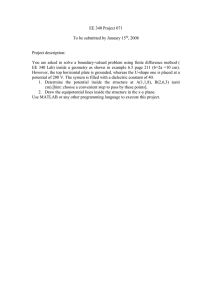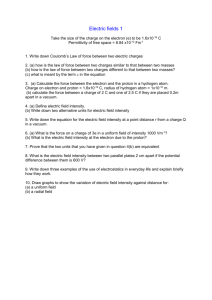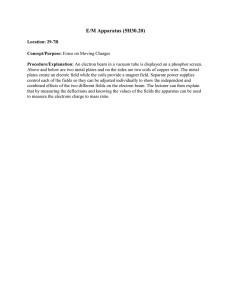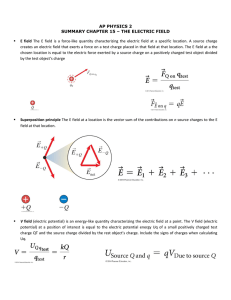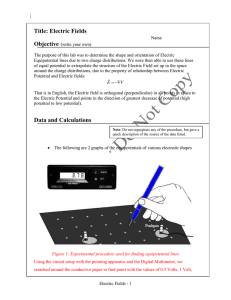Static Electricity
advertisement
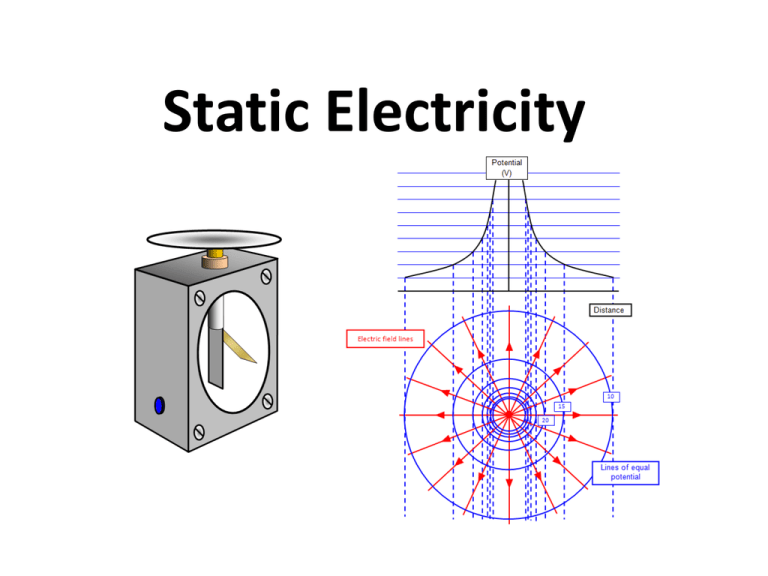
Static Electricity Contents Topic Page Contents Page Static electricity 3 Charging by contact & induction 15 Coulomb’s law 4 Electric fields 16 Action of a dielectric 5 Charge flow and electric current 17 Electric field intensity (EE) 6 Cathode ray tube 18 Electric potential 7 Van de Graaff generator 19 Equipotential lines & surfaces 8 20 Charge distribution 9 21 Uniform electric field 10 22 A hollow charged conductor 11 23 Radial field and potential 12 24 Electric field & potential gradient 13 25 Gold leaf electroscope 14 26 Static electricity Coulomb’s Law The force between two charges Q1 and Q2 separated by a distance d is expressed by Coulombs law: Force between charges: F = (1/4pε)Q1Q2 /d2 where ε is a constant for a given material known as the permittivity of that material. Changing ε changes the force between the two charges, for example if ε is large the force is small. In a vacuum this equation becomes: Force between two charges in a vacuum: F = [1/4pεo]Q1Q2 /d2 where εo is the permittivity of free space (8.84x10-12 Fm-1) Action of a dielectric If a dielectric material is placed in an electric field the charges within it separate although this separation does not cause conduction. If a dielectric material is placed between the plates of a charged capacitor opposite charges will be induced on the two surfaces of the dielectric. This has the effect of reducing the potential difference across the capacitor. Electric field intensity (EE) The strength of the electric field is measured using a quantity called the electric field intensity (EE). The greater the electrical field intensity the stronger the field. The electric field intensity is the force on a unit positive charge placed at that point in the field. (units Newtons per coulomb (NC-1). In a uniform field the electric field intensity is constant (the same at any point in the field) while in a radial field the electric field intensity decreases as the distance from the central charge increases. For a radial field the electric field intensity distance d from a positive charge of size Q coulombs is: Radial field: EE = (1/4peo)Q/d2 For a uniform field between two parallel plates separated by a distance d and with a potential difference V between them the field is: Uniform field: EE = V/d Electric potential The electric potential at a point in an electric field is defined as the work done in bringing a unit positive charge from infinity to that point. Electrostatic potential: VE = (1/4pεo)Q/d The unit of electrostatic potential is the volt (V). When one positive charge moves away from another positive charge its potential energy is decreased but when a negative charge is moved away from a positive charge (e.g. electron and proton) its potential energy increases. Electrostatic potential energy = qVE= (1/4pεo)qQ/d Equipotential lines and surfaces A line of equipotential is a line joining points of equal potential just like a contour line on a mountainside. Since E = -dV/dx the closer the lines of equipotential are the greater is the field strength. An equipotential surface is a surface which joins points of equal potential and therefore a surface on which the potential does not vary. This means that if you connected a wire between two points on the surface no current would flow between them. The analogy with gravity could be two small lakes at equal height on a mountain side - if a pipe connected the two together no water would flow along it in either direction. On the surface of a conducting solid electric currents are free to flow - they would do this until the potential at all points is the same and so the surface of the solid would become an equipotential surface. A line of force is always at right angles to an equipotential surface, it shows the "downhill" motion of a positive charge. Charge distribution 1. Assume that the potential is equal over the surface. 2. The potential at a distance r from a sphere carrying a charge Q is: Potential (V) = [1/4peo]Q/r 3. Charge density of the sphere (s) = Q/4pr2 4. Potential (V) = [1/4peo]s4pr2/r = [1/eo]sr so Charge density (s) = Veo/ r 5. The charge density at a point on the surface of radius r is inversely proportional to r. (Note that the lines of the electric field will always be at right angles to the surface). Uniform electric field In the uniform field the electric field intensity is the same anywhere in the field (hence the name) and the potential decreases steadily with distance from one plate to the other. [dV = -Edx] A hollow charged conductor There is no charge inside a hollow charged conductor - all the charge is on the surface. This means that the electric field inside the sphere is also zero and the potential is constant. Radial field and potential Electric field and potential gradient Electric field intensity (E) = - Potential gradient E = – dV/dx The negative sign implies that measuring from the positive plate the potential drops with increasing distance. In a uniform field the electric field intensity is the same anywhere in the field (hence the name) and the potential decreases steadily with distance from one plate to the other. [dV = -Edx] However in a radial field round a point charge E is not constant and is then truly the gradient of the potential-distance curve at any point. Gold leaf electroscope Charging by contact and induction Electric fields Charge flow and electric current Cathode ray tube A beam of electrons is shot down an evacuated tube by an electron gun. This beam passes between two sets of deflecting plates and then strikes a screen that glows when the beam hits it (fluorescence). (a) electron gun - this produces the electron beam. The more electrons there are in the beam the brighter the spot on the screen. (b) deflecting plates - by putting a voltage on each pair of plates the beam can be moved up and down or side to side. (c) fluorescent screen - this glows when the electron beam hits it. The Van de Graaff generator This machine is a useful way of using static electricity to produce very high voltages. The machine is used both in schools and in nuclear research where it can produce up to 10 million volts! A rubber belt passes a series of points or a sharp metal bar and charge is sprayed onto the belt from there. This charge is carried up by the belt to another series of points where it is collected and then stored on a large metal dome. As the belt rotates more and more charge is given to the dome.
